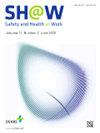Literature Review on Construction Safety Resilience: A Bibliometric Analysis to Map the State of the Art
IF 2.9
3区 医学
Q1 PUBLIC, ENVIRONMENTAL & OCCUPATIONAL HEALTH
引用次数: 0
Abstract
Background
This study provides a comprehensive overview of the research progress on construction safety resilience and sets up a three-subdimension concept framework (structural resilience, psychological resilience, and managerial resilience) with the theory of engineering resilience.
Methods
With a three-step review method based on document metrics analysis and scientific measurements, this study screened 1,018 related articles published on the Web of Science, and 168 articles were finally selected as research samples. The VOSviewer software was used to analyze the number of publications, the journals, and the keyword co-occurrence. The software-generated visual graphics and tables were described and summarized.
Results
The results show that the existing research on construction safety resilience mainly focuses on three streams: structural resilience, psychological resilience, and managerial resilience. Previous studies on structural resilience mostly focus on the physical aspect of a construction project, while the research on psychological and managerial resilience mainly relates with the personal and managerial aspects of a construction project, respectively. The differences, influencing factors, and measuring methods for these three research streams on construction safety resilience were also explored. Future studies could distinguish them more clearly with their definitions, measurements, and relationships.
Conclusion
This study helps to clarify the framework of construction safety resilience and provides a theoretical basis for the evaluation and development of resilient construction safety management, which may be beneficial for future studies on construction safety resilience.
建筑安全弹性的文献回顾:以文献计量学分析来反映目前的状况
本研究综述了建筑安全弹性的研究进展,并以工程弹性理论为基础,构建了结构弹性、心理弹性和管理弹性三个维度的概念框架。方法采用文献计量分析和科学测量相结合的三步回顾法,筛选Web of Science上发表的1018篇相关论文,最终选取168篇作为研究样本。采用VOSviewer软件对论文发表数量、期刊数量、关键词共现情况进行分析。对软件生成的可视化图形和表格进行了描述和总结。结果现有的建筑安全弹性研究主要集中在结构弹性、心理弹性和管理弹性三个方面。以往对结构弹性的研究主要集中在建筑项目的物理方面,而对心理弹性和管理弹性的研究主要涉及建筑项目的个人方面和管理方面。探讨了三种研究方向在建筑安全弹性方面的差异、影响因素和测量方法。未来的研究可以更清楚地区分它们的定义、测量和关系。结论本研究有助于厘清建筑安全弹性的框架,为弹性建筑安全管理的评价和发展提供理论依据,对未来建筑安全弹性的研究有益。
本文章由计算机程序翻译,如有差异,请以英文原文为准。
求助全文
约1分钟内获得全文
求助全文
来源期刊

Safety and Health at Work
Social Sciences-Safety Research
CiteScore
6.40
自引率
5.70%
发文量
1080
审稿时长
38 days
期刊介绍:
Safety and Health at Work (SH@W) is an international, peer-reviewed, interdisciplinary journal published quarterly in English beginning in 2010. The journal is aimed at providing grounds for the exchange of ideas and data developed through research experience in the broad field of occupational health and safety. Articles may deal with scientific research to improve workers'' health and safety by eliminating occupational accidents and diseases, pursuing a better working life, and creating a safe and comfortable working environment. The journal focuses primarily on original articles across the whole scope of occupational health and safety, but also welcomes up-to-date review papers and short communications and commentaries on urgent issues and case studies on unique epidemiological survey, methods of accident investigation, and analysis. High priority will be given to articles on occupational epidemiology, medicine, hygiene, toxicology, nursing and health services, work safety, ergonomics, work organization, engineering of safety (mechanical, electrical, chemical, and construction), safety management and policy, and studies related to economic evaluation and its social policy and organizational aspects. Its abbreviated title is Saf Health Work.
 求助内容:
求助内容: 应助结果提醒方式:
应助结果提醒方式:


